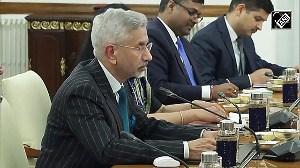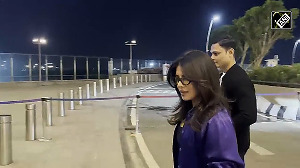Given that it is a low-energy, low-emission mode of transportation that can reduce costs significantly, India should not miss the opportunity to develop high-speed rail, notes Ramakrishnan T S.

It has been reported that Japan has offered to finance the Mumbai-Ahmedabad high-speed rail (HSR) corridor, estimated to cost about Rs 90,000 crore (Rs 900 billion), at an interest rate of less than one per cent.
Whenever any news item on HSR appears, questions revolving around whether India really needs HSR are raised.
Without cogent and coherent answers to these questions, it will be impossible for HSR projects to gain larger acceptance.
This article attempts to consolidate the doubts generally raised about HSR in India and provide comprehensive explanations.
The first question is: Why should we develop HSR when air travel exists for faster travel between cities?
India's transport demand will triple or quadruple in the next three decades, and given that the negative externalities in terms of energy consumption and emissions are high for air travel, it is a great opportunity for India to go for low-energy and low-emission modes such as HSR.
HSR is comparable with air travel in terms of end-to-end travel time for most inter-city trips of distances up to 600 km in case of HSR and 1,300 km in case of super-HSR such as maglev.
In addition, India can also claim carbon credits for resorting to low-carbon transport - without losing on travel time.
Thus, HSR is a better option in terms of energy efficiency, carbon footprint and inter-city travel time than air travel.
The second question is: Why can't we upgrade railway lines to provide semi-HSR, such as the one proposed for the Delhi-Agra link, with a maximum speed of 160 km per hour?
Our existing railway lines are used by different trains of different speeds, due to variances in the capacity of locomotives and stoppages for passenger trains.
This cannot practicably be changed. Operating a few trains at 160 kmph might showcase our ability but it would further reduce the throughput of our railway tracks due to huge differentials in speed.
To meet India's rail transport demand, there should be three sets of double tracks: the first one for conventional trains, the second for freight trains, and the third for HSR in the high-traffic-density corridors such as Golden Quadrilateral (GQ) and its diagonals.
Ignoring this ground reality would escalate our internal and external costs of transport.
This is evident from the fact that in the absence of sufficient rail capacity, both passenger and freight business has moved to road transport - and this trend would continue unabated.
The third question: Is India at the state of economic development where it could build HSR?
The rule of thumb for the timing of investment is that in the first year of construction of HSR, the country's real per capita gross domestic product (GDP) at purchasing power parity (PPP) has to be at least $5,000.
As reported by the World Bank, India's real per capita GDP at PPP was $5,244 in 2014.
So India has reached the economic level where it is appropriate to time investment into HSR.
Moreover, there has been continuous upward mobility in terms of demanding more comfortable and faster travel across all sections of society in India.
The preliminary work in terms of preparation of detailed project report and the tendering process may take about two years, the land acquisition may take about two years more and the actual construction, testing and commissioning may take another five years.
So the first HSR train would not be ready earlier than 2024.
Given the current growth rate, the average per capita real income would be at least 50 per cent more in 2024 than what it is in 2015.
This would ensure willingness and affordability to pay for faster travel with comfort. HSR is the best bet to meet this requirement.
The fourth question is: Why should the government splurge on HSR when there are other pressing needs, including developing conventional rail infrastructure and social infrastructure such as schools and hospitals?
HSR has been planned on GQ and its diagonal routes of North-South and East-West corridors (NSEW), which are high-density corridors for both passenger and freight traffic.
Indian Railways has planned HSR only on these high-demand routes. The government has no intention of developing HSR using its own funds - it would remain the facilitator in the execution of the project.
As and when the corridors become financially viable, they would be taken up for HSR execution either with 100 per cent foreign direct investment or through public-private partnerships, or some other format where the government funding would be nil.
Thus the question of splurging taxpayer's money on HSR projects does not arise at all.
The fifth question is: How do we handle land requirement and fencing of HSR lines?
According to the International Union of Railways, to construct one kilometre of HSR (two lines), 3.2 hectares per km is required, whereas to construct a six-lane highway, 9.3 hectares per km is required.
Given the difficulties associated with land acquisition in India for infrastructure projects and the compensation being introduced with the Right to Fair Compensation and Transparency in Land Acquisition and Rehabilitation and Resettlement Act, 2013, the lower land requirement of HSR for a transport corridor with higher passenger carrying capacity is a boon.
The cost of about Rs 165 crore per km for HSR includes underground and elevated tracks in congested urban areas as well as provisions for fencing, centralised safety monitoring and other safety-related costs, among other things.
HSR would also reduce our crude oil import and dependency, energy consumption, carbon emissions and pollution and increase the overall supply of rail transport.
By diverting people from travelling by road, HSR would also reduce road accidents.
It would be a great loss to the country as a whole, if the construction of HSR is delayed indefinitely.
The author has a PhD in public systems from Indian Institute of Management, Ahmedabad. These views are personal.











